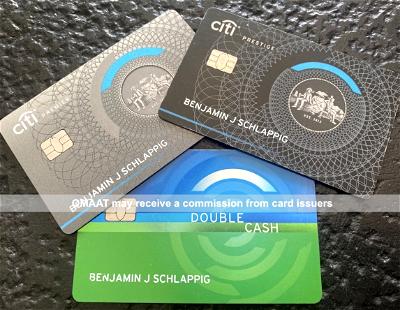For those looking to earn Amex Membership Rewards points, there are arguably two best personal cards for doing so — the American Express® Gold Card (review) and the American Express® Green Card (review).
These are both fantastic cards, though I’d argue that they’re substitutes for one another, so for a vast majority of people, it only makes sense to have one card or the other. Which card makes the most sense for you? Well, I’m going to address that in this post.
The information and associated card details on this page for the American Express Green Card has been collected independently by OMAAT and has not been reviewed or provided by the card issuer.
In this post:
Comparing the Amex Gold Card & Amex Green Card
Below let’s take a look at various aspects of the Amex Gold Card and Amex Green Card. Let’s discuss the approval odds, annual fees, return on spending, general card perks, and more.
For the purposes of this comparison, I’ll be leaving out the welcome offers, since those can change over time. However, in general you’ll find that the Amex Gold Card has a better welcome offer than the Amex Green Card. With that out of the way, let’s get right into it.
Comparing Amex approval odds
The Amex Gold Card and Amex Green Card should be comparable in terms of approval odds:
- Both cards are considered hybrid cards for approval purposes, rather than credit cards
- The cards don’t count toward Amex’s five credit card limit, as hybrid cards are excluded from that
- Anecdotally I find Amex hybrid cards to be pretty easy to get approved for

Comparing Amex annual fees
Annual fees are one of the biggest considerations that people have when deciding on a credit card. There is a significant difference between the fees on these two cards:
- The Amex Gold Card has a $325 annual fee (Rates & Fees)
- The Amex Green Card has a $150 annual fee
Obviously the Amex Green Card wins in this category, as the card will cost you significantly less every year. However, that largely reflects the difference in value that the cards will offer for many consumers.
Comparing Amex points earning structures
Both the Amex Gold Card and Amex Green Card earn Membership Rewards points, which can be transfered to airline & hotel partners to maximize value. As a benefit of Membership Rewards, you also get access to a limited complimentary version of point.me! Login here to see the reward flight options available with your Amex points, along with step-by-step booking instructions.
The main reason you’ll want to pick up either of these cards is because of the return on spending that they offer. Note that both cards have no foreign transaction fees, so are potentially good for purchases abroad.
The Amex Gold Card rewards structure offers:
- 4x points on dining globally (on up to $50,000 in purchases per calendar year, and then 1x)
- 4x points at U.S. supermarkets (on up to $25,000 in purchases per calendar year, and then 1x)
- 3x points on flights booked directly with airlines or through amextravel.com
- 1x point on other purchases

The Amex Green Card rewards structure offers:
- 3x points on dining globally
- 3x points on travel and transit
- 1x points on all other purchases

Which card wins here?
- The Amex Gold Card is one of the very best cards out there for both dining and supermarket spending, and is also great for airfare; if you spend a lot on eating (whether at restaurants or grocery stores), this is the card for you
- The Amex Green Card is extremely well-rounded in offering bonus points on both dining and travel, so in that sense it’s almost comparable to the Chase Sapphire Reserve® Card (review)
Comparing Amex benefits & perks
The Amex Gold Card and Amex Green Card offer some perks that can go a long way to offset the annual fees on the cards. Which perks are more valuable to you could help you decide which card is better in terms of justifying the annual fee. (Enrollment is required for select benefits)
The Amex Gold Card offers an impressive array of credits and benefits, including:
- Up to $120 in Uber Cash annually, by adding your Amex Gold Card to your Uber account; receive $10 in Uber Cash every calendar month directly to your Uber account, to be used toward U.S. Uber rides or U.S. Uber Eats orders, across one or more multiple transactions. An Amex Card must be selected as the payment method for your Uber or Uber Eats transaction to redeem the Amex Uber Cash benefit
- Up to $120 toward dining annually; receive up to $10 in statement credits each calendar month for purchases in the U.S. with Grubhub, The Cheesecake Factory, Goldbelly, Wine.com, and Five Guys
- Up to $100 in credits through Resy; this comes in the form of a $50 semi-annual credit (January through June and July through December), with eligible purchases being for U.S. Resy restaurants
- Up to $84 in annual Dunkin’ credits; this comes as a $7 monthly Dunkin’ credit, valid for purchases at U.S. Dunkin’ locations

The Amex Green Card isn’t as robust in terms of the perks that it offers. It simply offers up to $199 in CLEAR® Plus credits every calendar year. Just charge an eligible CLEAR purchase to your card, and you’ll receive a statement credit up to that limit.

Which card wins here?
- With the Amex Gold Card, you get an impressive array of perks, and I tend to think that both the Resy and Uber Cash benefits are really easy to use; the dining credits and Dunkin’ credits might be a bit more niche, but could still be valuable
- With the Amex Green Card, the CLEAR credit could be valuable, though a similar perk is offered with The Platinum Card® from American Express (review), so that will be redundant for many
As you can see, in both cases the annual credits alone can largely justify the annual fees, assuming you can use them. However, I think the Amex Gold Card credits are much more impressive and widely useful, though they do have a bit of a “coupon book” philosophy.
The information and associated card details on this page for the American Express Green Card has been collected independently by OMAAT and has not been reviewed or provided by the card issuer.
Bottom line
The Amex Gold Card and Amex Green Card are two of American Express’ best personal cards for earning points. Generally speaking, I think it only makes sense to have one card or the other, since there is quite a bit of overlap. As far as picking the right card goes, here’s how I’d think about it:
- If you spend a lot on dining and supermarkets, then the Amex Gold Card is an absolute must-have, as earning 4x points in those categories is awesome; the benefits and credits can also help largely offset the annual fee
- If you are committed to the Amex ecosystem and spend a lot on dining out and travel, then the Amex Green Card is Amex’s best competitor to the Chase Sapphire Reserve in terms of rewards structure
While I don’t think you can go wrong with either card, I think the Amex Gold Card is an especially good Amex card based on many peoples’ spending profiles.
Where do you stand — do you prefer the Amex Gold Card or Amex Green Card?
The information and associated card details on this page for the American Express Green Card has been collected independently by OMAAT and has not been reviewed or provided by the card issuer.
The following links will direct you to the rates and fees for mentioned American Express Cards. These include: American Express® Gold Card (Rates & Fees).





i'm dumping the Amex Gold card. I've had it for the last 7 years; but I just dont spend enough on it to make it worth my while. Why they are jacking up the fee AGAIN is beyond me.
I only keep the Green card so I can still access MR points (I have several) and to hold on to Clear.
can you double dip the uber credit. $20 from AMEX Platinum plus $10 from gold. Or is it one or the other
yes.
Capital One has really improved on its shopping extension where I can get rewards using any card, then flip them for a hotels.com gift card. I also got a surprise credit on a flight price drop. Capital One Travel has come along nicely since its rocky Venture X start. I recently got the CSP for the welcome offer (via the link, thanks Ben), my first Chase card, so we'll see how that goes.
The...
Capital One has really improved on its shopping extension where I can get rewards using any card, then flip them for a hotels.com gift card. I also got a surprise credit on a flight price drop. Capital One Travel has come along nicely since its rocky Venture X start. I recently got the CSP for the welcome offer (via the link, thanks Ben), my first Chase card, so we'll see how that goes.
The Green removed the Lounge Buddy credit and never replaced it with anything equivalent. I already get Clear Plus through the Platinum. It works on Grab SE Asia, and Transport for London, but remains limited in its use internationally. The points don't really rack up with Grab being as inexpensive as it is. It's hard to justify holding on to the card. I plan on closing the account when my anniversary date comes around.
@Hobbs I do agree that it totally sucks that AMEX removed the Lounge Buddy passes without adding any reasonable replacement for it. Though, I do not think AMEX Green is limited internationally. It depends on what you need for it and how you use it so of course it is different for everyone. It works great for restaurants including Starbucks around the world with its 3x points. Also, the transit 3x points is so broad....
@Hobbs I do agree that it totally sucks that AMEX removed the Lounge Buddy passes without adding any reasonable replacement for it. Though, I do not think AMEX Green is limited internationally. It depends on what you need for it and how you use it so of course it is different for everyone. It works great for restaurants including Starbucks around the world with its 3x points. Also, the transit 3x points is so broad. It works on hotels, airlines (not only just airfare but anything that codes as airline), transport such as trains, third party travel booking platforms, etc. I have gotten so much more versatile use out of when compared to the co-branded credit cards.
I love the AMEX Green card. The annual fee is not that cheap but very doable when compared to the high end premium credit cards. AMEX is very good at calculating the correct points you get for bonus categories. So far, only one problem with the erroneous bonus points but AMEX was able to fix it on the spot while calling it in and hopefully it will always stay that way. The only other error...
I love the AMEX Green card. The annual fee is not that cheap but very doable when compared to the high end premium credit cards. AMEX is very good at calculating the correct points you get for bonus categories. So far, only one problem with the erroneous bonus points but AMEX was able to fix it on the spot while calling it in and hopefully it will always stay that way. The only other error was with the annual credit but AMEX fixed it immediately as well.
With Chase, I had to get them to fix it constantly but it was so annoying as I had to submit receipts (vendor receipt and credit card receipt if possible and screenshots of the transactions posted online (which was fine) but somehow AMEX was able to make it an easy fix by looking over the transactions posted online. I have switched over to AMEX green card as much as possible especially if it relates to dining and transit.
Nice review. I’ve had the Green Card since 1983. I’ve played the offers to upgrade to Gold then Platinum then back down to Green after at least double dipping on the Platinum fight credits, etc.
Currently have the Green Card since but with 2 Platinum Bix Cards. ;-)
The big issue I have with the AMEX Green card is that the bonus categories are almost exactly the same as the categories on the Chase Sapphire Preferred so if you combine those cards together in a wallet, you're splitting your spending. The AMEX Gold card integrates better with other cards. Expensive and I keep thinking about dumping it but keep holding off.
Certainly, the analysis is different when talking about a two-card wallet . . . and what that second card is. Another consideration is acceptance of Amex outside the US. Separately, as I note in a prior comment, the rumored CSR refresh will drop "other travel" to 1X. So, perhaps hold off dropping the Amex Green.
Oh I don't have the CSR, I have the CSP so any changes won't affect me unless they start changing the latter card as well. Don't have the AMEX Green, either; all my "travel" spend goes onto the CSP or a co-brand hotel card.
The *rumored* refresh on the Chase Sapphire Reserve will purportedly downgrade "other travel" to 1X. Given the Amex Green's broad "other travel" category, those with a meaningful level of spending on non-portal rental cars, transit, parking, etc., will find it attractive.
I actually find the Dunkin and Resy credits to have been very worthwhile additions to the Amex Gold card. Dunkin credit, as dumb as it originally seemed, is actually pretty easy to maximize with no spoilage each month. A couple of cups of coffee a month. In contrast, the dining credit, you are likely ordering a $50 Grubhub order to access a $10 credit. The Resy credit, at $50 a half, is also pretty easy...
I actually find the Dunkin and Resy credits to have been very worthwhile additions to the Amex Gold card. Dunkin credit, as dumb as it originally seemed, is actually pretty easy to maximize with no spoilage each month. A couple of cups of coffee a month. In contrast, the dining credit, you are likely ordering a $50 Grubhub order to access a $10 credit. The Resy credit, at $50 a half, is also pretty easy to access. Those credits made the Gold even more worthwhile.
The Green seems to be most useful for those that spend a lot on transit, and as a downgrade option for the Amex Platinum.
Agreed. Although, I'd use the monthly dining credit in a different way. I've found that GrubHub pricing is about 10 percent higher than DoorDash on the restaurants I use. YMMV.
Agreed on Resy, I've found a place close by that I can actually use it at so that's now face value for me. The Grubhub, Uber, and Dunkin credits are useless for me though. I don't eat at Dunkin, I don't use Grubhub, Uber, or UberEats. If I need quick food I'll walk across the street for a sandwich or to Publix. I could theoretically use one of those credits on Cheesecake Factory but I...
Agreed on Resy, I've found a place close by that I can actually use it at so that's now face value for me. The Grubhub, Uber, and Dunkin credits are useless for me though. I don't eat at Dunkin, I don't use Grubhub, Uber, or UberEats. If I need quick food I'll walk across the street for a sandwich or to Publix. I could theoretically use one of those credits on Cheesecake Factory but I really don't want to eat at that place once a month and only get a $10 discount. Once I cash out my MR I'm definitely ditching the Gold card unless something changes on the value proposition in the meantime.
Agree. No issue using Resy, since there are lots of Resy restaurants around in my area and when I travel. The Dunkin near me is a combo Dunkin/Baskin Robbins, but it rings up as Dunkin. So, I add $7 a month to my Dunkin account (triggers the credit) and periodically treat my family to ice cream. As far as The Cheesecake Factory, there is one 12 minutes away, and every month I buy one piece...
Agree. No issue using Resy, since there are lots of Resy restaurants around in my area and when I travel. The Dunkin near me is a combo Dunkin/Baskin Robbins, but it rings up as Dunkin. So, I add $7 a month to my Dunkin account (triggers the credit) and periodically treat my family to ice cream. As far as The Cheesecake Factory, there is one 12 minutes away, and every month I buy one piece of Cheesecake to go. As far as Uber, I can combine the $10 Uber credit with the Platinum $15 Uber credit with the Bonvoy $25 dining credit, so that gives me $50 per month to buy a meal for the family at the local pizza place that I pick up (6 minutes away) to save the delivery fee. All together, Gold is definitely a keeper for me under the current structure.